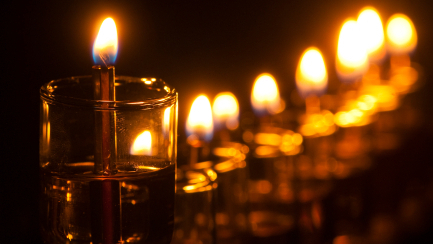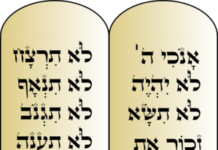Although Chanukah is over, the memories, the warmth, the light, the kedusha of the menorah still shine through the cold and dark winter.
Chanukah is a time to give thanks to G-d for the miracles He performed with both the military victory over the Greeks and the oil of the menorah in the Temple lasting 8 days. The reason we put our menorahs by the window (or outside, in Israel) is to publicize these miracles. The special prayers we add over Chanukah express our thanks and praise to G-d.
On a personal level, our family was especially filled with thanks and praise to G-d for the beautiful wedding we celebrated the Thursday before Chanukah of our son, Yisrael Tzvi to Chavie Hamaoui. Besides all our family and friends who shared in our simcha, almost 40 JET students, many of whom are now married themselves and whose weddings we attended, joined us.
The simcha continued with sheva brachot, the traditional six days of celebration that follow the wedding. The last 4 days of sheva brachot overlapped with Chanukah. Much of the Torah thoughts shared and words of bracha given to the chatan and kallah, were Chanukah related.
Rabbi Hamaoui, the father of the kallah, quoted Rashi in Mesechet Shabbat that when the menorah was lit in the Mishkan, the torch was held by each lamp until the flame went up by itself. The language used is ‘l’ha lot’ to ‘raise up’ the flame. Rabbi Hamaoui connected this to the concept of the wedding. It is a parent’s job to raise one’s child until he/she is ready to ‘go up’ to the chupah on their own. The parent keeps the torch there until the child is ready to cast a light of his/her own. Perhaps this is symbolized by the parents walking their child to the chupah and then letting them go.
Yisrael Tzvi and Chavie have truly brought light into our lives and all those who know them. Their marriage was the time as parents to let them shine a light of their own.
Our Rabbis teach us that the light of the menorah represents the light of Torah.
Just one day before the wedding, the Jewish community in Chicago and across the US, were plunged into darkness with the passing of the leader of our community, Rabbi Avraham Chaim Levin, zt’l, the Rosh Yeshiva of Telz Yeshiva in Chicago. Rabbi Levin spread the light of Torah through a faithful transmission of the mesorah (tradition) that he received from his Rebbe, Rabbi EliMeir Bloch. Yisrael Tzvi learned at Telz and we have two boys learning there now. I made a special effort when we first arrived in Chicago 20 years ago to develop a relationship with the Rabbis at Telz and I love going there to learn and daven to this day. I had the zechus (merit) to learn one Elul at Telz for morning seder and sat in the Rosh Yeshiva’s shiur (class). Rabbi Levin would have a beaming smile when he taught Torah. He had such simcha when he learned, the simcha just shone on his face.
Now we as a community are left to carry his torch on our own.
Although many of Rabbi Levin’s family were unable to attend the wedding, many of the Rabbis at Telz did attend. Many of the Telz bochurim came to dance and brought such simcha to us. As the Rosh Yeshiva taught his talmidim, a Jew can have two hergeishim (feelings) – happiness and sadness – at the same time.
We concluded the sheva brachot at Shaarei Tzedek Mishkan Yair, where we have been so fortunate on so many levels, both personally and with JET, to have been part of such a beautiful makom Torah and makom tefillah. It was an opportunity to thank Rabbi Reuven Gross and all the families, not only for arranging the sheva brachot, but also for their friendship and for truly sharing our simcha.
I also thanked the Hamaouis for a wonderful couple of months, from the moment the shidduch was suggested, through all the excitement of the L’chaim and vort, the preparations for and the wedding itself, all the sheva brachot.
I thanked my wife and children and thanked Yisrael Tzvi and Chavie. I thanked Hashem.
The word Chanukah contains the letters ‘chet’ and ‘nun’, which spell the word cheyn. It is a word that appears in one of the brachot that the kohanim give Klal Yisrael. “Ya’eir Hashem panav eilecha – vichuneka.” May Hashem lift up His face and endow you with chayn. It’s a hard word to translate into English. Some translate it as grace or favor. Mothers pray that their children have chayn.
Rabbi Nachman Bulman ob’m, my Rebbe at Ohr Somayach, explained this blessing to us and taught us a most beautiful idea.
Simply the blessing means: “May you find favor in the eyes of other people.” It also means – may you be able to bestow favor. May you find favor in others. On a spiritual level, a person should look at G-d’s world and see a good world with good people.
As Rashi says – May he show you a panim tzachakos, smiling face, panim tzahuvos, a glowing face. Let Him show you Himself in such a way that the face of whatever you see should radiate the sense of His presence. And as a result He will give you chayn and make others find chayn in you.
When a person sees hashgacha (divine providence) in their life, when a person sees that the world radiates G-d’s presence, that the world is good, then he or she will become infused with that, and others will see it radiating it from them. Others will say that they are shining through Him.
So my bracha to the young couple was (and to all who are reading this is): “May you always feel Hashem’s hashgacha, His smiling face in the world. May you always see the chayn in G-d’s world and in others and may G-d and others always see the chayn in you.”







